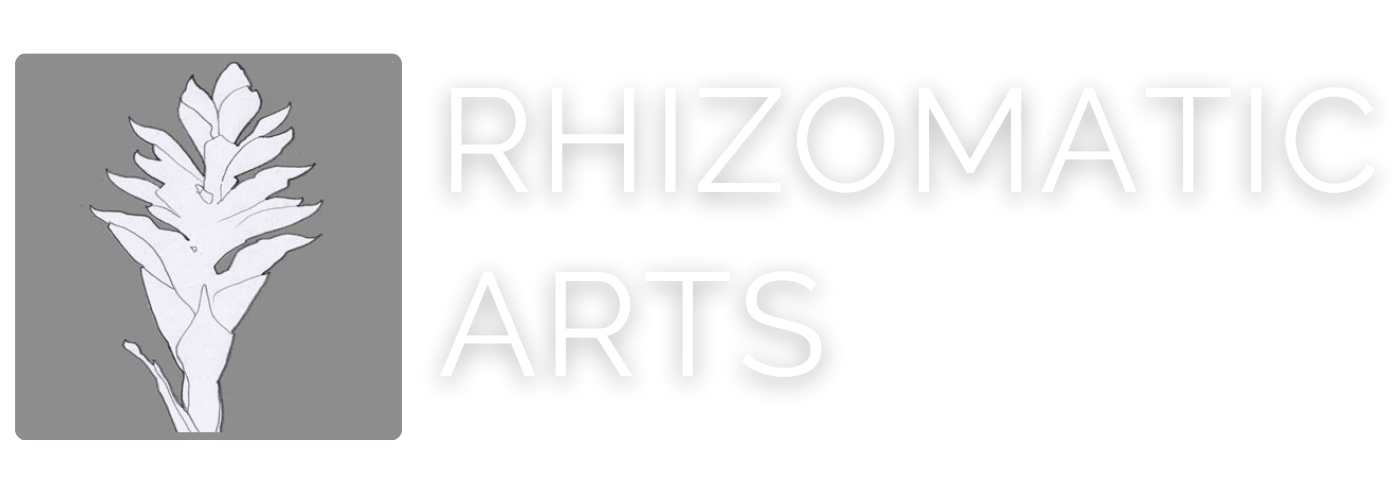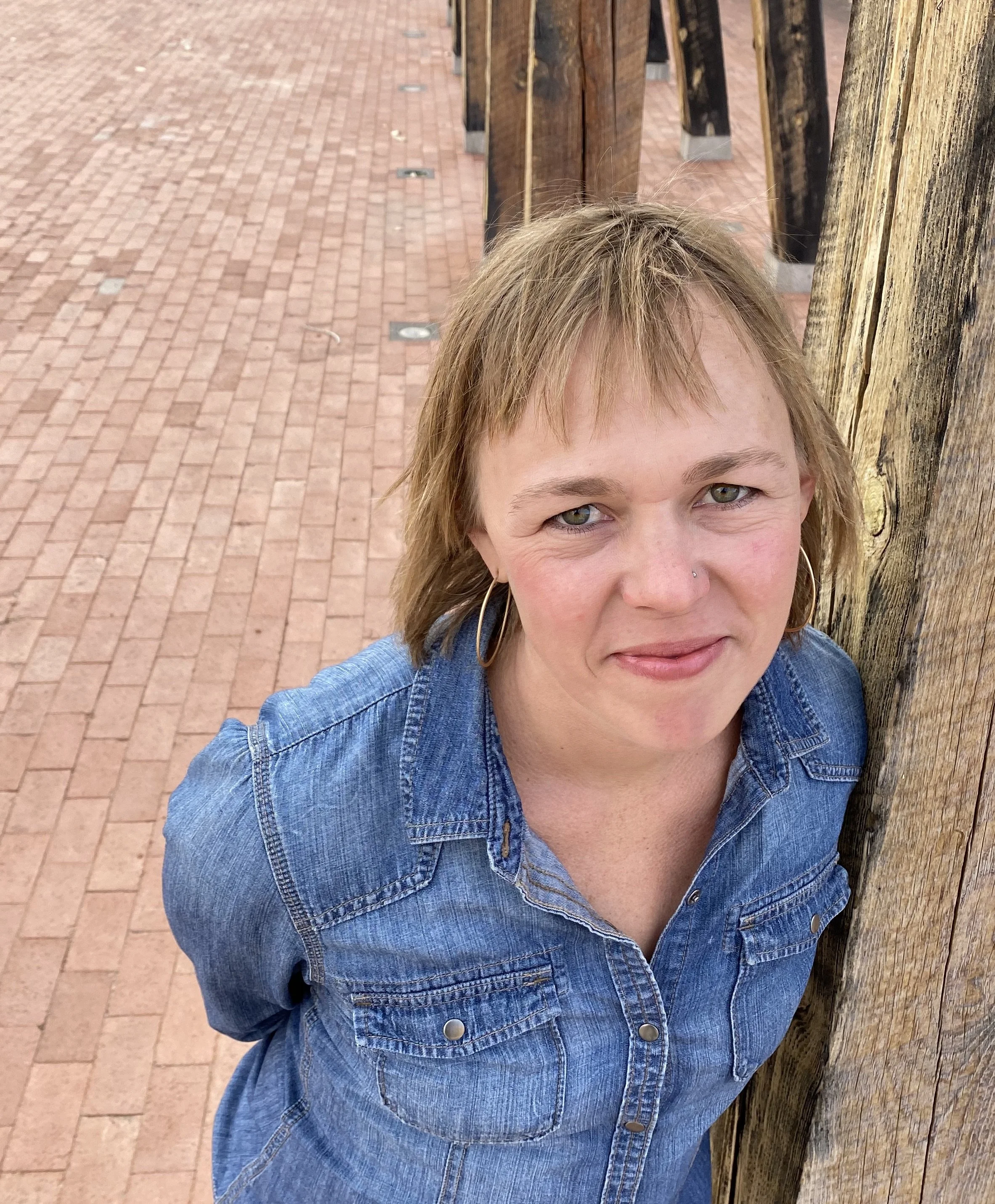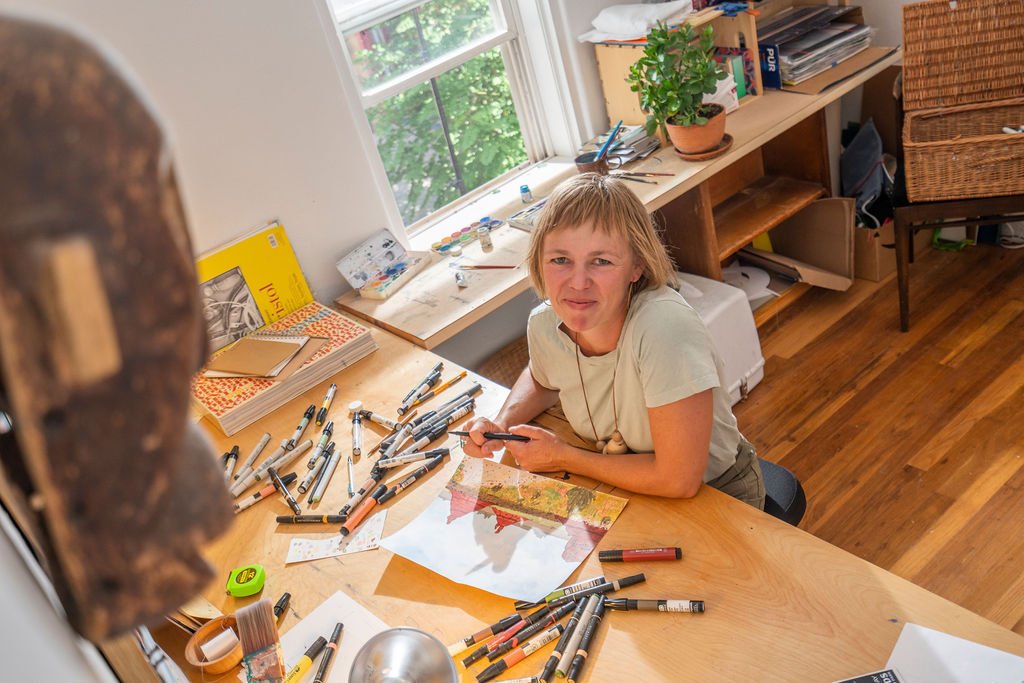Project Spotlight: Erin Elder + Gibbous
When I met Albuquerque-based ERIN ELDER, I immediately recognized a professional soul mate. She takes a personal, therapeutic approach to supporting artists in their careers over weeks, months, or even years. “Because I come to know artists in all of their uniquenesses,” she says, “we are able to move through challenges, overcome obstacles, find opportunities and words and resources that resonate with their specific values and goals… Whether I’m cheerleading, listening carefully, giving feedback, asking questions or providing accountability, I hope my clients feel less alone and more courageous in doing their very important work.”
Erin Elder, artist and founder of Gibbous
Erin, how do you describe what you do in the world?
Like most creative people, I wear many different hats and never know exactly how to answer the question of what I do. I’m trained as a curator and have organized numerous DIY projects and exhibitions; I’ve had institutional jobs and for several years I co-operated an experimental residency program for artists. In recent years, I’ve found my own creative voice which takes the forms of writing, drawing, and creative research. I have a background in experiential education which influences the way I work — I’m often trying to facilitate direct encounters with specific places, whether that encounter is geared towards artists, students, or public audiences. I’m very interested in land use and sense of place and over the last 20 years, my work has taken a variety of forms to address different sites, issues, and communities.
I’m currently an Innovator in Residence at Colorado College, where I am conducting a multi-year project about the complex and often-overlooked life of a nearby urban creek. I’m also working towards an exhibition of my exuberant landscape drawings that will open in February. In spring 2023, I hope to release my third book, an illustrated memoir about finding solace in nature while reckoning with aging, childlessness, death, climate collapse, and a global pandemic.
Backgrounding all of this work is Gibbous, a platform for working with artists in long-term, deeply impactful ways. Since 2015, I have offered confidential one-on-one career development to hundreds of artists at pivotal stages of their lives. I work with artists in all mediums, but often they have a hybrid practice that touches the visual arts in some way. I love this work for so many reasons; in particular, I appreciate how it inspires and accommodates my own creative work.
Erin in the studio.
How do you help artists thrive?
Throughout my career as a curator and now through Gibbous, I have been able to ask artists two essential questions: (1) what do you want to do? and (2) how can I help you get there? Starting with inquisitiveness, deep listening, and a commitment to meet artists exactly how and where they are has allowed me to know artists very intimately. And because I come to know artists in all of their uniquenesses, we are able to move through challenges, overcome obstacles, find opportunities and words and resources that resonate with their specific values and goals. There is no singular art world, just as there is not a 1-2-3 path to success. I love working with artists to find satisfaction in their lives and work in ways that feel aspirational, inspiring, affirmative, and doable.
In a more tactical sense, I help artists express their work through project descriptions, artist statements, grant applications, exhibition proposals, and websites. My support for these writing-centered projects is more impactful when I know how a client sees themselves. Much of the work is, therefore, grounded by conversations about priorities, big decisions, emerging values, and opportunities. Whether I’m cheerleading, listening carefully, giving feedback, asking questions or providing accountability, I hope my clients feel less alone and more courageous in doing their very important work. Teamwork is potent. I’ve seen it behave like jet fuel in an artist’s career trajectory.
What brought you to this work?
I’ve been working in the arts for over 20 years in various different capacities and contexts — as an educator, curator, administrator, in arts nonprofits, museums, commercial galleries, and for private collectors. I have a rich history of starting and participating in DIY projects. So, In 2015, when I was organized out of my job as the visual arts director at a contemporary art center, I knew I had to DIY a job for myself. At that pivotal moment, a friend asked: what do you know how to do? Who do you want to serve? The answers come easily: I know how to support people administratively and creatively. I want to serve artists.
After operating Gibbous for nearly seven years, I cannot imagine doing anything else. As I said earlier, I appreciate that this work allows time and space for my own creative projects, but even if those personal projects were to garner greater support and resources, I would still want to work with artist clients as I do now. I love helping people feel seen and heard and I love helping to keep their creative spark lit and burning. I get a vicarious hit from watching other people succeed.
I’m not sure if it’s my affordable rates or the confidentiality I extend to clients or something more nuanced about the character of how Gibbous operates, but I am constantly astounded by my clients’ generosity, trust, and long-term commitment to our work. Some of my clients have been with me for 5 or 6 years! I’ve seen them through all kinds of career milestones and challenges, not to mention marriages, divorces, births, empty nests, sickness, loss, and recovery. I tend to believe that everything is connected so I appreciate the opportunity to talk through existential crises and relationship upheavals as well as the big ideas, projects, and opportunities.
Artwork by Erin Elder.
What would a sustainable career look like for you?
This is such a good question! I am 43 years old, unmarried, and without children. Two years ago I bought a house near a river with a small farm in the backyard. I have a long-term partner and two dogs, a few very close friends and many wonderful acquaintances, hobbies I love, work that feels important and that sustains me, as well as time to pursue my creative projects. I have a camper van and travel quite a bit throughout the West and Mexico. I feel nimble in my life because I have little responsibility and little overhead. Though I have a lot to be grateful for, I live close to the bone. I couldn’t do this work and live this life in a bigger or more expensive city. And I couldn’t do it while also raising children. I made these trade-offs years ago and though they continue to be challenging in some ways, I’m grateful for what my life has become. I prioritize ease and beauty and balance.
It feels unusual to have found my niche in early middle age. Sometimes I wonder if I’ve gotten lazy or if my goals are not big enough. I wonder if, at some point, I will need to make more money (though I don’t want to raise my rates or only work with rich people.) Sometimes I wonder if I’ll crave more visibility. I reflect on the fact that although I’ve been very poor for most of my adult life, I have always gotten by. I am learning to trust that there is enough money, enough time, enough work, enough rest, enough attention, enough love. As long as I stay attuned to what’s happening and as long as I stay creative, I trust it will all be (more than) okay.
Based on what you’ve learned from your work and community, what changes would you like to see in the coming years?
One of the things I’m recognizing in many of my clients and fellow artists is the desire to be involved with projects, partnerships, and gigs that amplify their values. And because my own values center on land and land use, I see a lot of folks responding to the climate collapse and ecological loss, shepherding collective grief, making space for underrepresented voices, and illuminating narratives about peoples and places that are invisible, forgotten, or intentionally erased. I believe we are at a moment when the world needs artists more than ever before. I hope that governments and institutions can find ways to involve artists, trust artists, fund artists, and otherwise support artists in doing what they can uniquely do. Whether artists crave solitary studio time or community engagement, fieldwork, research, or poetry, I hope that the creative process (all creative processes) can become as valued as sciences, politics, religion, business, and our other culture-shaping enterprises. Artists can solve problems and create solutions, but more importantly they can help cultivate care. We need artists to help make meaning as we move through a very intense era of global change. I pray that I’ll be part of that change, supporting those who are bold enough to do what only they can do.



